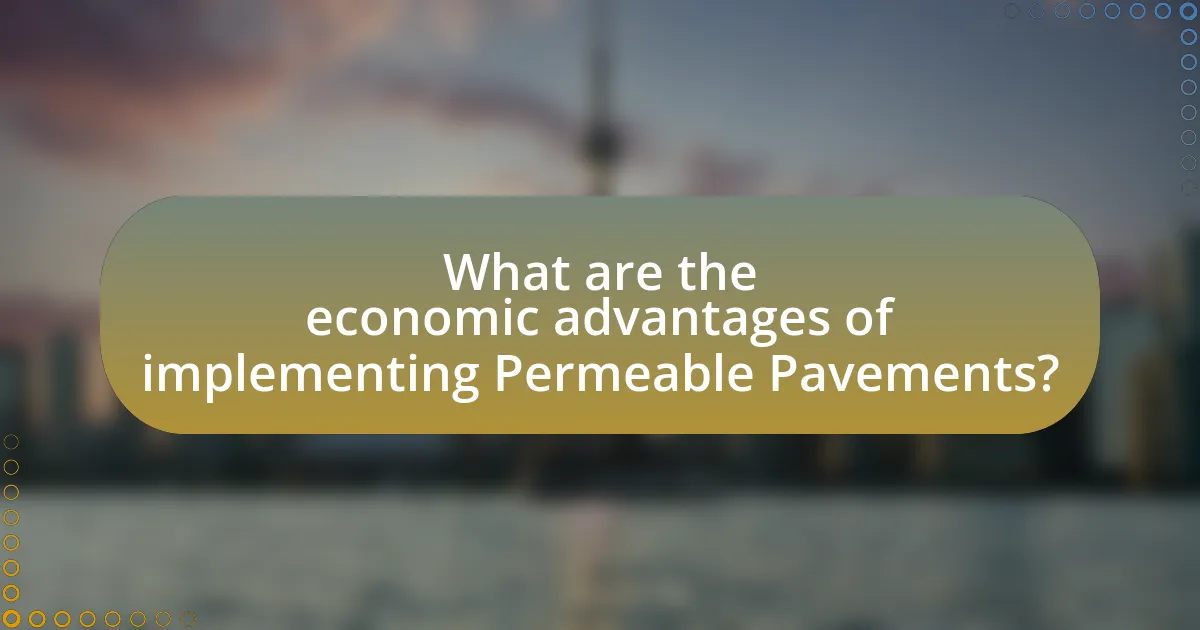Permeable pavements are innovative surfaces designed to facilitate water infiltration, thereby reducing stormwater runoff and enhancing groundwater recharge. This article explores the functionality of permeable pavements in stormwater management, detailing the materials used in their construction and their significant environmental benefits, including improved water quality and reduced urban heat island effects. Additionally, it addresses the economic advantages of implementing permeable pavements, such as lower infrastructure costs and increased property values, while also outlining best practices for effective design and maintenance. The article emphasizes the importance of permeable pavements in urban planning and their role in mitigating flooding and enhancing sustainability in urban environments.

What are Permeable Pavements?
Permeable pavements are surfaces designed to allow water to infiltrate through them, reducing runoff and promoting groundwater recharge. These pavements consist of materials such as porous asphalt, permeable concrete, or interlocking pavers that create voids for water to pass through. Studies indicate that permeable pavements can significantly decrease stormwater runoff by up to 50% compared to traditional impervious surfaces, thereby mitigating flooding and improving water quality.
How do Permeable Pavements function in stormwater management?
Permeable pavements function in stormwater management by allowing water to infiltrate through their surface, reducing runoff and promoting groundwater recharge. This type of pavement is designed with materials that create voids, enabling rainwater to pass through and be absorbed by the underlying soil or a designated storage layer. Studies indicate that permeable pavements can reduce surface runoff by up to 80%, effectively mitigating flooding and erosion while improving water quality by filtering pollutants.
What materials are used in the construction of Permeable Pavements?
Permeable pavements are constructed using materials such as porous asphalt, permeable concrete, and interlocking concrete pavers. These materials are specifically designed to allow water to infiltrate through the surface, reducing runoff and promoting groundwater recharge. For instance, porous asphalt consists of a mixture of asphalt and aggregate that creates voids for water to pass through, while permeable concrete utilizes a similar approach with larger aggregates and fewer fine particles to enhance permeability. Interlocking concrete pavers are designed with gaps that facilitate water drainage. These materials collectively contribute to effective stormwater management by mitigating flooding and improving water quality.
How does water infiltrate through Permeable Pavements?
Water infiltrates through permeable pavements by passing through the surface material, which is designed to allow water to flow through its voids. This process begins when rainwater or runoff reaches the permeable surface, where it seeps into the underlying layers, typically consisting of gravel or other porous materials that facilitate drainage. Studies indicate that permeable pavements can reduce surface runoff by allowing up to 80% of precipitation to infiltrate, thereby mitigating flooding and promoting groundwater recharge.
Why are Permeable Pavements important for urban environments?
Permeable pavements are important for urban environments because they facilitate stormwater management by allowing water to infiltrate through the surface, reducing runoff and mitigating flooding. This infiltration helps recharge groundwater supplies and decreases the burden on drainage systems, which can lead to improved water quality by filtering pollutants. Studies indicate that permeable pavements can reduce surface runoff by up to 80%, significantly lowering the risk of urban flooding and erosion.
What challenges do traditional pavements pose for stormwater management?
Traditional pavements pose significant challenges for stormwater management by creating impermeable surfaces that prevent water infiltration. This leads to increased surface runoff, which can overwhelm drainage systems and contribute to flooding. According to the U.S. Environmental Protection Agency, traditional pavements can increase runoff by 55% to 75%, exacerbating water quality issues as pollutants are carried into waterways. Additionally, the lack of natural absorption can result in higher temperatures in urban areas, known as the urban heat island effect, further complicating stormwater management efforts.
How do Permeable Pavements mitigate flooding risks?
Permeable pavements mitigate flooding risks by allowing water to infiltrate through their surface, reducing surface runoff. This infiltration process helps to manage stormwater effectively, as it decreases the volume of water that would otherwise contribute to flooding. Studies have shown that permeable pavements can reduce runoff by up to 80% compared to traditional impermeable surfaces, thereby significantly lowering the risk of urban flooding during heavy rainfall events.

What are the environmental benefits of Permeable Pavements?
Permeable pavements provide significant environmental benefits by facilitating stormwater management and reducing urban runoff. These pavements allow water to infiltrate through the surface, which helps recharge groundwater supplies and minimizes the risk of flooding. According to a study by the U.S. Environmental Protection Agency, permeable pavements can reduce surface runoff by up to 80%, thereby decreasing the burden on stormwater systems and improving water quality by filtering pollutants. Additionally, permeable pavements can mitigate the urban heat island effect by allowing for cooler surface temperatures, contributing to a healthier urban ecosystem.
How do Permeable Pavements improve water quality?
Permeable pavements improve water quality by allowing rainwater to infiltrate through the surface, reducing runoff and filtering pollutants. This infiltration process helps to trap sediments, heavy metals, and nutrients, preventing them from entering stormwater systems and local water bodies. Studies have shown that permeable pavements can reduce total suspended solids by up to 90% and nitrogen levels by approximately 50%, significantly enhancing the quality of water that eventually reaches groundwater and surface water sources.
What pollutants can Permeable Pavements filter out?
Permeable pavements can filter out various pollutants, including sediment, heavy metals, nutrients, and hydrocarbons. Studies have shown that permeable pavements effectively reduce the concentration of pollutants such as zinc, copper, and lead, which are commonly found in urban runoff. For instance, research conducted by the University of New Hampshire found that permeable pavements can remove up to 90% of total suspended solids and significantly reduce the levels of heavy metals and nutrients, thereby improving water quality in stormwater management systems.
How does the infiltration process enhance groundwater recharge?
The infiltration process enhances groundwater recharge by allowing water from precipitation and surface runoff to permeate through soil and rock layers into underground aquifers. This process increases the volume of water that enters the groundwater system, replenishing aquifers that are essential for maintaining water supply. Studies indicate that permeable pavements can significantly improve infiltration rates, with some systems achieving infiltration rates of up to 10 times greater than traditional impervious surfaces. This increased infiltration not only supports groundwater levels but also reduces surface runoff, mitigating flooding and promoting sustainable water management practices.
What role do Permeable Pavements play in reducing urban heat islands?
Permeable pavements play a significant role in reducing urban heat islands by allowing water to infiltrate through the surface, which cools the surrounding area. This infiltration process reduces surface temperatures by promoting evaporation and maintaining moisture levels in the soil beneath. Studies have shown that permeable pavements can lower surface temperatures by up to 10 degrees Fahrenheit compared to traditional impervious surfaces, thereby mitigating the heat retention commonly associated with urban environments.
How do Permeable Pavements contribute to temperature regulation in cities?
Permeable pavements contribute to temperature regulation in cities by allowing water to infiltrate through the surface, which reduces surface runoff and mitigates the urban heat island effect. This infiltration process cools the surrounding air and pavement surfaces, leading to lower ambient temperatures. Studies have shown that permeable pavements can lower surface temperatures by up to 20% compared to traditional impervious surfaces, as they promote evaporation and reduce heat absorption. Additionally, the presence of vegetation in conjunction with permeable pavements enhances cooling through transpiration, further aiding in temperature regulation within urban environments.
What are the long-term ecological impacts of using Permeable Pavements?
The long-term ecological impacts of using permeable pavements include improved groundwater recharge, reduced urban heat island effects, and enhanced water quality. Permeable pavements allow rainwater to infiltrate through the surface, promoting the replenishment of aquifers and maintaining natural hydrological cycles. Studies have shown that areas with permeable pavements can experience a 50% increase in groundwater recharge compared to traditional impervious surfaces. Additionally, these pavements can mitigate the urban heat island effect by allowing moisture to evaporate, which cools the surrounding environment. Furthermore, permeable pavements filter pollutants from stormwater, leading to improved water quality in nearby water bodies, as evidenced by research indicating a reduction in runoff pollutants by up to 90%.

What are the economic advantages of implementing Permeable Pavements?
Implementing permeable pavements offers significant economic advantages, primarily through reduced stormwater management costs. By allowing water to infiltrate through the pavement, municipalities can decrease the need for extensive drainage systems, which can be costly to install and maintain. For instance, a study by the U.S. Environmental Protection Agency found that permeable pavements can reduce the volume of stormwater runoff by up to 80%, leading to lower infrastructure expenses. Additionally, permeable pavements can enhance property values; properties with such features often attract buyers seeking sustainable solutions, which can result in a 10-15% increase in value. Furthermore, these pavements can reduce urban heat island effects, potentially lowering energy costs for cooling buildings. Overall, the economic benefits of permeable pavements include lower infrastructure costs, increased property values, and reduced energy expenses.
How can Permeable Pavements reduce infrastructure costs?
Permeable pavements can reduce infrastructure costs by minimizing the need for extensive stormwater management systems. These pavements allow water to infiltrate through the surface, reducing runoff and the associated costs of constructing and maintaining traditional drainage systems. For instance, a study by the U.S. Environmental Protection Agency found that permeable pavements can lead to a 30-50% reduction in stormwater management costs compared to conventional methods. This cost-effectiveness arises from decreased infrastructure requirements, lower maintenance expenses, and potential reductions in flood damage.
What are the maintenance costs associated with Permeable Pavements?
The maintenance costs associated with permeable pavements typically range from $0.50 to $2.00 per square foot annually. These costs include regular vacuuming to remove sediment, periodic replenishment of the aggregate base, and occasional repairs to maintain permeability. Studies indicate that effective maintenance can extend the lifespan of permeable pavements, making them a cost-effective solution for stormwater management over time.
How do Permeable Pavements affect property values?
Permeable pavements positively affect property values by enhancing aesthetic appeal and promoting environmental sustainability. Properties with permeable pavements often experience increased demand due to their ability to manage stormwater effectively, reducing flooding risks and improving local water quality. A study by the University of New Hampshire found that properties adjacent to permeable pavement installations saw a 10% increase in value compared to similar properties without such features. This increase is attributed to the perceived benefits of reduced stormwater runoff and improved neighborhood aesthetics, making permeable pavements a valuable investment for property owners.
What incentives exist for adopting Permeable Pavements in urban planning?
Incentives for adopting permeable pavements in urban planning include reduced stormwater management costs, improved water quality, and enhanced urban aesthetics. These pavements allow rainwater to infiltrate the ground, thereby decreasing runoff and the need for extensive drainage systems, which can save municipalities significant expenses. Studies indicate that permeable pavements can reduce peak runoff by up to 80%, leading to lower infrastructure costs. Additionally, they filter pollutants from stormwater, improving water quality in nearby bodies of water. Furthermore, permeable pavements can enhance the visual appeal of urban areas, contributing to increased property values and community satisfaction.
How do government policies support the use of Permeable Pavements?
Government policies support the use of permeable pavements through incentives, regulations, and funding programs aimed at enhancing stormwater management. For instance, many municipalities offer tax credits or grants to property owners who install permeable pavements, thereby reducing runoff and improving water quality. Additionally, regulations may mandate the use of permeable materials in new developments or redevelopment projects, promoting sustainable urban planning. Studies, such as those conducted by the Environmental Protection Agency, indicate that these policies lead to increased adoption of permeable pavements, which effectively mitigate flooding and enhance groundwater recharge.
What funding opportunities are available for projects involving Permeable Pavements?
Funding opportunities for projects involving permeable pavements include federal grants, state-level funding programs, and local government initiatives. For instance, the Environmental Protection Agency (EPA) offers grants through its Clean Water State Revolving Fund, which supports projects that improve water quality, including stormwater management solutions like permeable pavements. Additionally, many states have specific programs aimed at enhancing green infrastructure, which often includes funding for permeable pavement installations. Local municipalities may also provide incentives or rebates for property owners who implement permeable pavements to manage stormwater effectively.
What are best practices for implementing Permeable Pavements effectively?
Best practices for implementing permeable pavements effectively include proper site assessment, selecting appropriate materials, ensuring adequate subgrade preparation, and maintaining regular maintenance routines. Site assessment involves evaluating soil conditions, drainage patterns, and existing infrastructure to determine suitability for permeable pavements. Selecting materials that meet local regulations and performance standards is crucial; for instance, using high-quality aggregates can enhance permeability and durability. Adequate subgrade preparation ensures proper infiltration and load-bearing capacity, which is essential for the longevity of the pavement. Regular maintenance, such as vacuuming to remove debris and monitoring for clogging, is necessary to maintain functionality and prevent water quality issues. These practices are supported by studies indicating that well-implemented permeable pavements can significantly reduce stormwater runoff and improve groundwater recharge.
What factors should be considered when designing Permeable Pavements?
When designing permeable pavements, factors such as soil type, drainage capacity, climate conditions, and intended use must be considered. Soil type affects infiltration rates; for instance, sandy soils allow for faster drainage compared to clay soils, which can lead to water pooling. Drainage capacity is crucial to ensure that the pavement can handle expected stormwater runoff volumes without causing flooding. Climate conditions, including rainfall patterns and temperature fluctuations, influence the durability and effectiveness of the pavement materials. Lastly, the intended use, whether for pedestrian walkways or heavy vehicle traffic, determines the structural requirements and material selection to ensure longevity and performance.
How can communities ensure the longevity of Permeable Pavements?
Communities can ensure the longevity of permeable pavements by implementing regular maintenance practices, including cleaning and monitoring for clogging. Regular vacuuming or pressure washing removes debris and sediment that can obstruct water flow, which is essential for the pavement’s functionality. Studies indicate that well-maintained permeable pavements can last over 20 years, significantly longer than traditional pavements, provided they are kept clear of contaminants. Additionally, communities should educate property owners about the importance of maintaining these surfaces to prevent deterioration and ensure effective stormwater management.


